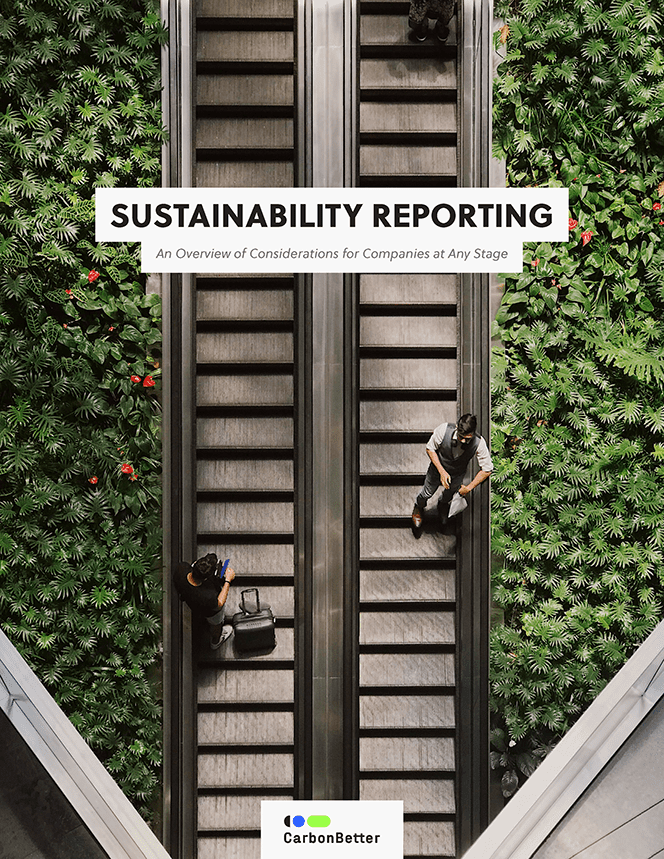Ask Us Anything Webinar Recap


As climate-related disclosure and mitigation requirements continue to evolve, understanding the latest regulatory landscape is essential for US companies. In this webinar, we cut through the jargon to provide clear insights into emerging climate-related requirements, breaking down two key federal proposals and one EU regulation impacting some US-based companies. Join us to stay informed and prepared for what’s ahead in climate compliance.

SUSTAINABILITY REPORTING OVERVIEW
Sustainability reporting serves as a valuable tool to achieve corporate commitments and better manage climate-related business risks. This white paper walks you through what’s typically included and what should be considered.
Insights from our AMA-style webinar on all things sustainability.
Hello, and welcome to the recap of our May 2023 Q&A with Nicole Sullivan, former Director of Climate Services at CarbonBetter. During this Q&A session, we addressed several practical aspects related to initiating and developing sustainability strategies for businesses. The session was designed to clarify and provide insights into diverse topics such as integrating sustainability into operations, performing carbon accounting and reporting, setting sustainability goals, and navigating the world of carbon credits. The answers provided were based on practical experience and designed to help businesses comprehend and manage the challenges that come with implementing sustainability initiatives. In this post, we’ll provide a recap of the key takeaways.
Watch the full video replay.
Sustainability Strategy
As a small business just beginning our sustainability journey, which cost-effective strategies should we consider for integrating sustainability into our operations to make an immediate positive impact?
For any small business at the outset of their sustainability journey, my first advice is to start taking action, however small. Identify stakeholders within your organization who can champion this cause. Next, take stock of your current standing; understanding your status quo is crucial. Remember the adage, what gets measured gets managed. To start, you might calculate your carbon footprint or assess your water usage. From this baseline, you can begin to formulate a sustainability strategy and implementation plan tailored to your operation’s specific needs. It’s important to remember that each business is unique, so each sustainability strategy will be unique as well. For instance, the quick wins or “low-hanging fruit” for a manufacturing operation are likely to be vastly different from those of an office space. If you’re an office-based business, your main emission source could very well be electricity usage. Tackling this could offer a great starting point. So, essentially, the journey begins with understanding your current state, and then identifying and pursuing the most effective sustainability strategies for your specific operations.
How can we use the results of a materiality assessment to inform our sustainability strategy and drive meaningful change within our organization?
Materiality assessments can provide critical insights to inform and shape your sustainability strategy. They highlight the environmental, social, and governance (ESG) issues that matter most to your stakeholders and could significantly impact your business. The key is to align the results of your materiality assessment with your strategic decision-making. This alignment allows you to focus on the areas of highest impact and importance, essentially helping you prioritize your sustainability initiatives. Remember that transparency in sharing these results with stakeholders can help build trust and engage them in your sustainability journey.
How can we develop a holistic sustainability strategy that not only focuses on decarbonization but also addresses other critical aspects like water and waste management?
A holistic sustainability strategy goes beyond carbon and encompasses other critical areas like water and waste management. Here, your materiality assessment can guide you in identifying and prioritizing these areas. Each industry and company have unique sustainability challenges and opportunities, so what’s crucial is aligning your sustainability strategies with your core business goals and values. For example, if you’re in a water-intensive industry or located in a water-scarce region, water management might be a key focus area. Simultaneously, waste management is crucial for industries with significant material throughput. The end goal should be to create a sustainability strategy that’s truly holistic and integrated with your core business strategy.
How can we build a more sustainable supply chain by identifying, collaborating with, and ensuring our suppliers and partners are aware of and share our commitment to sustainability?
Building a sustainable supply chain involves understanding your supply chain’s current state, including the sustainability performance of your suppliers. You can begin by setting expectations for your suppliers around sustainability, possibly even including sustainability criteria in your contracts. Engage in regular communication and collaboration with your suppliers, and provide them with the necessary training and resources to enhance their sustainability performance. Remember, it’s not about policing your suppliers but rather collaborating with them to advance mutual sustainability goals. Supplier engagement can be a slow process, but it’s a crucial one in the journey toward building a more sustainable supply chain.
Carbon Accounting & Reporting
Our business is growing rapidly. How can we measure progress towards improving our impacts when our overall footprint is expanding as our business grows?
Even as your business grows, you can track your progress toward sustainability by focusing on emissions intensity metrics, which measure your impact relative to a certain business activity or output. For instance, you might consider your carbon emissions per unit of production or per dollar of revenue. This approach allows you to monitor your performance and improvements over time, irrespective of business growth. It also gives you the flexibility to set meaningful goals that align with your business’s growth trajectory, rather than just absolute reduction targets.
How can we report in a way that’s transparent and positive while avoiding greenwashing? Our leadership team is worried about disclosing our impacts.
To avoid greenwashing, be honest and transparent in your sustainability reporting. This includes acknowledging where you are today, even if it’s not where you’d like to be, and sharing your plans for improvement. Use credible, widely accepted standards and frameworks for your reporting, such as those from the Global Reporting Initiative (GRI) or the Sustainability Accounting Standards Board (SASB). These standards provide guidance on what to report, how to measure your impacts, and how to communicate them effectively. Stakeholders appreciate transparency and the acknowledgment of areas for improvement. So, embrace your starting point, outline your journey, and let your stakeholders join you on this path.
How do we account for Scope 3 emissions in our carbon footprint calculations and what actions can we take to reduce them?
Scope 3 emissions typically represent a significant part of a company’s carbon footprint and arise from sources not directly controlled by the company, such as suppliers, customers, or employee commuting. To account for these emissions, you’ll first need to identify and understand your Scope 3 sources. Tools like the GHG Protocol can guide you in this process. Once you’ve identified these sources, consider which ones are most significant and where you have the most influence. Here, collaboration with your suppliers or customers can play a key role. For instance, you could encourage suppliers to reduce their emissions or work with customers to promote the use of your products in a more sustainable manner.
Goal Setting
How do we set realistic and impactful sustainability goals for our organization?
Setting realistic and impactful sustainability goals involves understanding your current situation, defining what success looks like for your organization, and then mapping out the path to get there. Start with a baseline assessment to understand your current environmental impacts. Then, determine where you’d like to be in the future. This vision could be informed by science-based targets, stakeholder expectations, or industry best practices. Once you have a clear vision, you can set shorter-term goals that will guide you toward this long-term ambition. Remember, it’s important that these goals are both ambitious and achievable, and they should be integrated into your overall business strategy. It’s important to align these goals with broader sustainability frameworks, like the United Nations (UN) Sustainable Development Goals (SDGs).
Our company has achieved carbon neutrality. What are the next steps to strive for (e.g. carbon negativity)?
Achieving carbon neutrality is a significant accomplishment, so congratulations! The next step would be aiming for carbon negativity, which means removing more carbon from the atmosphere than you emit. This could involve investing in carbon removal projects or exploring ways to sequester carbon within your operations. However, it’s important to balance these efforts with a continued focus on reducing your own emissions. Ultimately, the aim should be to create a resilient, sustainable business model that thrives in a low-carbon economy.
Carbon Credits
When choosing carbon credits to offset our emissions, how can we choose high-quality carbon credits?
Selecting high-quality carbon credits involves a few key aspects. First, ensure the project you’re investing in is independently verified by a recognized standard, such as the Verra Carbon Standard (VCS) or the Gold Standard (GS). Next, the project should demonstrate additionality, meaning the carbon reduction wouldn’t have occurred without the project. Finally, consider the co-benefits of the project. Does it benefit local communities or biodiversity? A reputable carbon offset provider like CarbonBetter can guide you in identifying suitable projects that align with your sustainability goals and values.
We’ve done the math for our Scope 1 and 2 carbon footprint and want to offset that to achieve carbon neutral. Where and how do we buy carbon offsets?
Once you’re ready to offset your Scope 1 and 2 emissions, you can purchase carbon credits from various providers. These could be non-profit organizations, environmental consultancies, or dedicated carbon offset platforms. When selecting a provider, consider their reputation, the standards they use to verify projects, and the range and quality of projects they offer. Remember, your choice of offset projects should align with your company’s values and sustainability goals. Achieving carbon neutrality through offsetting can be a powerful step in your sustainability journey, but it should complement, not replace, efforts to reduce your own emissions.
Conclusion
Navigating the path to sustainability can seem complex, but you don’t have to do it alone. Whether you’re just beginning your journey, aiming to improve your carbon accounting and reporting, or looking for effective ways to set and achieve ambitious sustainability goals, CarbonBetter is here to guide you. Reach out to us today to get started.
At CarbonBetter, we believe in progress over perfection. It’s not about doing everything—it’s about doing something. With over a decade of experience in the energy industry, we partner with organizations to guide them in the transition to a net-zero economy. CarbonBetter’s sustainability specialists work closely with partners across all industries to integrate sustainability solutions seamlessly into any business.
CarbonBetter helps organizations of all sizes measure, reduce, report, and offset their emissions, and tell stories about their sustainability journey.
Telling stories about sustainability efforts helps other organizations take action that will then, in turn, inspire others—it’s never too early or late to start.